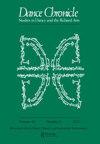黑人如何影响全球菲律宾群体:非裔菲律宾嘻哈舞蹈的体现与种族政治
IF 0.1
3区 艺术学
0 DANCE
引用次数: 0
摘要
J.Lorenzo Perillo在他的第一本书《彩色舞蹈》中探讨了非裔菲律宾嘻哈舞蹈的复杂体现和种族政治。他用街舞作为镜头来调查围绕非裔菲律宾文化的社会、文化、政治和经济背景。他通过带领读者穿越大陆、嘻哈活动、劳动力迁移和病毒式数字媒体来做到这一点。这本书以批判性种族理论为解释框架,展示了嘻哈舞蹈的不同细微差别如何体现围绕菲律宾身份跨国传播的动态。佩里洛通过多地点的双语民族志和舞蹈分析,旨在“揭示自20世纪末以来,菲律宾舞者如何以及为什么对嘻哈和街舞的全球普及产生了如此巨大的影响”(第2页)。佩里洛在整本书中解释了菲律宾人如何以美丽和暴力的方式与黑人联系在一起。他回到了过去,展示了殖民地的过去是如何影响菲律宾嘻哈舞蹈创新的。佩里洛认为,“菲律宾人参与嘻哈和街舞的方式与帝国、新自由主义和国家批准的暴力行为背道而驰,从而创造了一个空间,在这个空间里,他们通过舞蹈参与嘻哈可以被视为超越合作、模仿,甚至是挪用”(第2页)。换言之,佩里洛通过对黑人和菲律宾文化和身份之间的联系进行细致入微的分析,帮助我们看到黑人和菲律宾人之间可能存在的其他关系。因此,他的作品有助于讨论嘻哈及其他领域的文化挪用。佩里洛的理论框架借鉴了关于黑人表演、表演性和东南亚裔美国人研究的学术成果。他的作品明显受到黑人的影响本文章由计算机程序翻译,如有差异,请以英文原文为准。
How Blackness Informs Global Filipino Corporeality: The Embodied and Racial Politics of Afro-Filipino Hip-Hop Dance
In his first book titled Choreographing in Color, J. Lorenzo Perillo examines the complex embodied and racial politics of Afro-Filipino hip-hop dance. He uses hip-hop dance as a lens to investigate the social, cultural, political, and economic contexts surrounding Afro-Filipino culture. He does this by taking his readers on a journey through continents, hip-hop events, labor migrations, and viral digital media. Using critical race theory as an interpretative framework, the book showcases how the different nuances of hiphop dance can exemplify dynamics surrounding the transnational circulation of Filipino identities. Through a multi-sited, bilingual ethnography and choreographic analysis, Perillo aims to “uncover how and why Filipino dancers have made such a tremendous impact on the global popularization of hip-hop and street dance since the late twentieth century” (p. 2). Perillo explains throughout the book how Filipinoness is linked to Blackness in beautiful and violent ways. He goes back in time to show how the colonial past informs the Filipino hip-hop dance innovations of the present. Perillo argues that “Filipinos engage hip-hop and street dancing in ways that work with and against empire, neoliberalism, and state-sanctioned violence, thus creating a space where their participation in hip-hop through dance can be regarded as something beyond cooptation, mimicry, or, even still, appropriation” (p. 2). In other words, by offering nuanced analyses about the connections between Black and Filipino cultures and identities, Perillo helps us see other possible kinds of relatedness between Blackness and Filipinoness. Therefore, his work contributes to conversations about cultural appropriation in hip-hop and beyond. Perillo’s theoretical framework draws from scholarship on Black performance, performativity, and Southeast Asian American studies. His work is notably influenced by Black embodied
求助全文
通过发布文献求助,成功后即可免费获取论文全文。
去求助
来源期刊

DANCE CHRONICLE
DANCE-
CiteScore
0.40
自引率
0.00%
发文量
22
期刊介绍:
For dance scholars, professors, practitioners, and aficionados, Dance Chronicle is indispensable for keeping up with the rapidly changing field of dance studies. Dance Chronicle publishes research on a wide variety of Western and non-Western forms, including classical, avant-garde, and popular genres, often in connection with the related arts: music, literature, visual arts, theatre, and film. Our purview encompasses research rooted in humanities-based paradigms: historical, theoretical, aesthetic, ethnographic, and multi-modal inquiries into dance as art and/or cultural practice. Offering the best from both established and emerging dance scholars, Dance Chronicle is an ideal resource for those who love dance, past and present. Recently, Dance Chronicle has featured special issues on visual arts and dance, literature and dance, music and dance, dance criticism, preserving dance as a living legacy, dancing identity in diaspora, choreographers at the cutting edge, Martha Graham, women choreographers in ballet, and ballet in a global world.
 求助内容:
求助内容: 应助结果提醒方式:
应助结果提醒方式:


